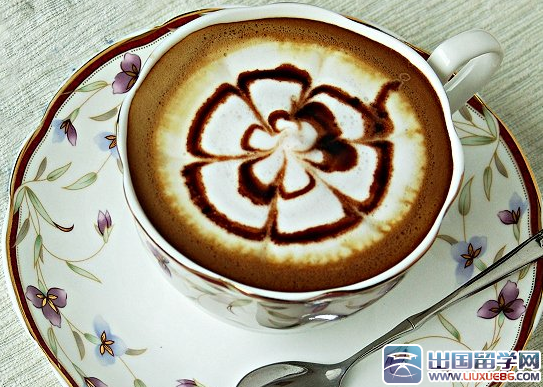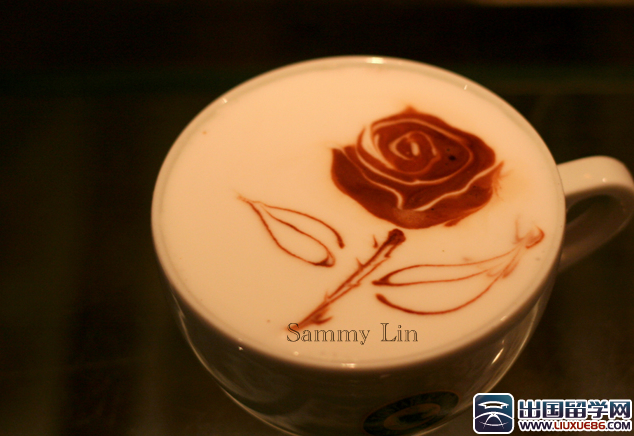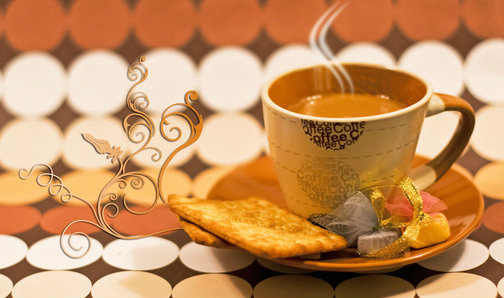Coffee etiquette full solution-how to elegantly drink (zhuang) coffee (ge) coffee (bi)
As we all know, the last procedure for eating western food is to drink coffee or tea. In addition, when dealing with Westerners, there are many occasions where we may need to have coffee together. The following is the etiquette of drinking coffee collected and sorted out for you. I hope you like it!

Coffee etiquette-coffee drinking steps
The first step is to smell the fragrance and taste the original aroma of coffee.
The second step is to look at the color. The coffee had better be dark brown, not dark and bottomless.
The third step, taste, first drink a mouthful of black coffee, feel the taste of the original coffee, coffee entrance do not rush to swallow the coffee, should be temporarily contained in the mouth, let the aroma of coffee exhale from the nasal cavity, and then swallow the coffee.
When tasting coffee, it is best to have a mouthful of cold water, so that you can get a fresh taste every time. Cold water is gargled in your mouth. The fourth step, according to personal preference, add the right amount of sugar, and stir with a small spoon, taking advantage of the stirring coffee whirlpool, slowly add cream balls, let the oil float on the coffee, maintain the heat of the coffee can also evaporate the milk flavor, enjoy the multi-layer taste.
Temperature: the best temperature for drink coffee is about 80 ℃. Because the texture of ordinary coffee is not stable, it is best to taste it while it is hot. In order not to reduce the taste of the coffee, preheat the coffee cup in advance. The appropriate temperature for coffee is 83 ℃ at the moment of brewing, 80 ℃ when it is poured into the cup, and 61-62 ℃ into the mouth.
Generally speaking, it is also the basic etiquette to drink coffee while it is hot and drink up the coffee as much as possible in ten minutes. If a cup of high-quality coffee, after cooling, in addition to the aroma will be reduced, the taste performance is consistent with the hot, or even better. Drinking pure coffee is a way to drink without damaging the taste. Add sugar or cream to the coffee to neutralize the bitter and sour taste of the coffee and make it taste good. Unlike drinking or fruit juice, a full cup of coffee loses interest in drinking.
Generally speaking, a moderate amount of coffee will not only stimulate the taste, but also will not feel greasy after drinking, making the body tired and the mind refreshed. At the same time, the right amount of coffee liquid can satisfy some guests who like to add sugar and milk directly, so as not to add sugar and milk to the cup.
Coffee has different flavors, so you can't drink several cups in a row like tea or cola. If you want to drink three or four cups in a row, you should dilute the concentration of coffee, or add a lot of milk, so as not to cause nausea, and you might as well change more in the blending of sugar to make the coffee more delicious.
Coffee etiquette-- the match of drinking coffee
● Coffee spoon: you will be laughed at if you drink coffee with a coffee spoon. Coffee spoons are only used to stir coffee, not to scoop coffee. Put the coffee spoon aside after stirring. Some coffee shops simply do not have coffee spoons, only disposable mixing sticks, the use is the same.
● Milk Bubble: also known as cream or coffee companion, it is actually a kind of plant milk extracted from plants and added with artificial flavors. it is only a temporary substitute for fresh milk, not real dairy products. Milk ball bubble cholesterol is very high, often used is bad for the health, drinking coffee had better use fresh milk as seasoning.
● raw sugar: many people like to add sugar to their coffee. In fact, a good cup of coffee is also particular about sugar. In order to save costs, most coffee shops will choose white granulated sugar, but it will affect the original taste of coffee. The really good coffee sugar should be raw sugar, also known as yellow sugar, large particles, yellowing color, put on the foam of fancy coffee, will not sink for a long time.
● coffee temperature: drink the coffee while it is hot. The coffee with the temperature between 91.6 ℃ and 96.1 ℃ can give off the original strong aroma, so it is best to choose porcelain cup with good heat preservation.

Coffee etiquette-part of etiquette that should be paid special attention to when drinking coffee
(1) how to get the coffee cup?
The coffee you drink after a meal is usually served in a pocket cup. The ear of this kind of cup is so small that you can't get your fingers out. But even if you use a larger cup, don't put your finger through the ear and carry the cup. The correct way to hold a coffee cup is to hold the handle of the cup by your thumb and forefinger and then pick up the cup.
(2) how to add sugar to coffee?
When adding sugar to the coffee, the sugar can be scooped out with a coffee spoon and added directly to the cup, but now the sugar bag in a separate small package is very easy to operate; you can also use a sugar clip to clip the cube sugar on the close side of the coffee plate, and then add the cube sugar to the cup with a coffee spoon. If you directly use the sugar clip or hand to put the cube sugar into the cup, it may sometimes spill the coffee, thus soiling the clothes or tablecloth, which is extremely impolite.
(3) how to use coffee spoon?
The coffee spoon is specially used to stir the coffee and should be taken out when drinking the coffee. No longer use a coffee spoon to scoop a spoonful of coffee to drink slowly, and do not use a coffee spoon to mash the cube sugar in the cup. Coffee spoons that have been stirred will be stained with coffee. Gently wipe off the juice along the inner edge of the cup. Never pick up the spoon and shake it, or lick the spoon with your tongue. It is best to put the used spoon on the inside of the tray so as not to knock it off when picking up the coffee cup. The standard stirring technique is to place the coffee spoon in the center of the coffee cup, circle clockwise from the inside to the outside, then circle the cup wall counterclockwise to the center, and then repeat the same technique to make the coffee even.
(4) what if the coffee is too hot?
Freshly brewed coffee is so hot that you can gently stir it in the cup with a coffee spoon to cool it, or wait for it to cool naturally before drinking it. It is very impolite to try to cool the coffee with your mouth.
(5) the use of cups and saucers?
People on TV sometimes drink coffee according to the etiquette of drinking tea, holding coffee cups with their hands or cups and saucers, so we have to follow suit. But this is wrong! You should put down the cup and saucer and drink only with the coffee cup.
(6) drinking coffee and snacks
Sometimes you can have some snacks when drinking coffee, but don't alternate between eating and drinking with a coffee cup in one hand and a snack in the other. You should put down the snack when you drink coffee and the coffee cup when you eat it.
(7) drinking coffee
Generally speaking, tasting the coffee served by your host while it is hot is the basic etiquette of drinking coffee. However, it should be noted that drinking coffee is not like drinking plain boiled water, drinking all the cups in one breath, and drinking coffee is not like drinking tea or juice, you can drink several cups in succession, so that the host will laugh at you or think you are rude. When a cup of coffee is brought to you, don't rush to drink it. There should be a gradual process like tea or wine tasting, so as to achieve the goal of relaxation, refreshing and enjoyment. A coffee connoisseur will first experience the strong fragrance when the coffee is served, that is, take a deep breath into the coffee cup, and all the beauty is here. Then, blow open the coffee oil and take a sip, which is the original flavor of the coffee, and then add sugar and milk as you like.
(8) Coffee tasting terms
The coffee tasting here actually refers to black coffee, which is very similar to wine appreciation:
Clean: coffee has no earthy taste, no wild taste, no major flaws and uncomfortable features.
Balance: features that are complex and interesting enough, but none that stand out.
Texture, taste (Body, Mouthfeel): texture refers to the thick, sticky touch of coffee in the mouth, which is proportional to the amount of colloid suspension in coffee. Since the texture is felt throughout the mouth, we use "rich" to describe thick coffee and vice versa as "thin".
Complexity (Complexity): refers to the different levels of characteristics that coexist in the same cup of coffee, high complexity, indicating that you can feel more kinds of sensory stimuli; it should be noted that these feelings include the afterrhyme and are not necessarily limited to the feelings of drinking.
Depth (Depth): this is a more subjective adjective that refers to resonance and appeal beyond sensory stimulation, which may be caused by meticulous sensations or complex interactions between different senses.
Bitter (Bitter): this is the characteristic of deep baked beans, which, like sour taste, is not necessarily uncomfortable, but the sensation of the whole mouth and throat, not just the tongue. Generally speaking, friends who drink American coffee or Saifeng coffee may use "strong" to describe this feature.
Sweet: it has two meanings. The first is to feel the stimulation of sweetness, which is commonly known as sweetness; the other means that the taste of sugar is reminiscent of sugar, which is partly astringent and rich in texture; the tip of the tongue does not have to react.
Smooth: refers to a weak sour and bitter taste.
Acidity (Acidity): the taste of coffee left on the tip of the tongue after it is imported. The word "sour" looks eye-catching, but in fact, the original flavor and fresh vitality of coffee beans, like wine, are contained in its sour taste. The acidity of fresh coffee, with the aroma of fruit, is like the natural acid in lemon, grape, apple and other fruits, which is pleasant and fresh.
Aroma: the mellow smell of coffee in the wandering air. From roasting, grinding to brewing, coffee beans try their best to release their fragrance at every stop of its long journey. Therefore, you might as well make good use of your sense of smell and experience this fragrant journey with coffee.
Flavor (Flavor): some coffee flavors are diverse, sour, sweet and bitter, while others are extremely sour, completely occupying your sense of smell and taste. There are also people who are used to using "feeling" to dominate judgment-does coffee have its own style? Does it have a unique forest or fruit aroma? Is your temperament gentle or masculine? This is the most intimate and emotional stop in all the tasting processes.
Coffee etiquette-matters needing attention in drinking coffee
1. The fingers of the end cup should not pass through the ear of the cup:
The coffee you drink after a meal is usually served in a pocket cup. The ears of this kind of cup are so small that fingers cannot pass through, so there is no need to worry about "making a fool of yourself" in full view of the public. However, when you encounter a large cup, you must remember not to carry the cup with your finger through the ear of the cup. The correct posture is to hold the cup handle and pick up the cup with your thumb and forefinger.
2. After adding sugar, you don't have to stir:
When adding sugar, the sugar can be scooped with a coffee spoon and added directly to the cup, or you can first use a sugar clip to clip the cube sugar on the near side of the coffee plate, and then add the cube sugar to the cup with a coffee spoon. Do not directly use the sugar clip or hand to put the cube sugar into the cup to avoid spilling coffee and soiling clothes or tablecloths. After adding sugar, there is no need to stir the coffee hard, because the sugar and milk melt quickly. If you don't like sugar and milk, turn the cup ear to your right.
3. The coffee spoon is not for scooping coffee:
Add sugar and stir coffee is the "full-time" coffee spoon, use it to scoop a sip of coffee is a rude thing, and do not use it to "help" smash the cube sugar in the cup. When drinking, take it out of the cup and put it on the plate.
4. It is not elegant to cool the coffee with your mouth:
Drink coffee while it is hot. If it is too hot, gently stir it with a coffee spoon to cool it, or wait for it to cool naturally before drinking. If you try to cool your coffee with your mouth, remember that this is an impolite gesture.
5. Just carry a coffee cup when drinking:
Generally speaking, you only need to pick up the cup when drinking coffee. It would be rude to pick up the plate or hold the bottom of the cup to drink coffee. Unless there is no table to rely on, you can use the left hand to hold the plate and the right hand to hold the coffee cup ear to taste slowly. Also note that you can't hold the cup full, swallow it, and don't bow your head to the coffee cup. Don't take the coffee cup off the plate when adding coffee.
6. drink coffee and snacks "at the wrong time":
You can have a snack when drinking coffee, but you can't take a coffee cup in one hand, take a snack in the other, eat and drink alternately.
Instead, you should put down the snack when you drink coffee and the coffee cup when you eat it.
7. Special reminders for guests and guests at home:
Don't treat your guests to coffee at home, especially when your guests happen to be coffee lovers, let them add their own milk and sugar, because they are very particular about it. In addition, you should carefully prepare a cup of cold boiled water for connoisseurs who know how to drink coffee, so that guests can taste coffee alternately between cold boiled water and coffee.
When drinking coffee as a guest at a friend's house, it is polite to finish the coffee while it is hot. But don't finish your coffee in one breath, sip it slowly. If you just talk and snub the coffee to cool it, that is a waste of the host's mind.

Coffee etiquette-how to find your favorite coffee according to your own taste?
Master the following steps, in any coffee shop, you can customize a cup of private coffee that best suits your own taste.
(1) say whether you want a cold drink or a hot drink.
(2) whether you need decaf coffee: if you are worried that caffeine will cause insomnia, you can ask for decaf coffee.
(3) the dose of ESPRESSO coffee solution: if you love the bitterness of coffee, you can ask for double ESPRESSO.
(4) the taste of syrup: coffee shops usually have syrup with flavors of vanilla, chocolate, hazelnut, raspberry and so on.
(5) what kind of milk to add: in addition to whole milk and skim milk, some coffee shops also offer soy milk as an option, considering that some people are allergic to milk.
(6) personal requirements: for example, whether it should be particularly hot, or how much ice or milk foam is needed.
(7) Coffee name: for example, mocha, latte, cappuccino, American coffee, etc.
(8) how to enjoy a good cup of coffee
A good cup of coffee should be clear and bright with a strong sense of transparency. Concentration and turbidity are different. Generally speaking, the causes of coffee turbidity are nothing more than the following:
◎ mixed with defective coffee beans
Poor baking of ◎
◎ coffee beans or powder have been kept too long
Excess ◎ brewing (the brewing temperature is too high, the brewing time is too long, the flushing mode is too rough …) When you put a spoon into a good coffee, the light of the spoon will sparkle; then scoop up and drip back, you will find that at the moment of falling, the coffee liquid will form a jewel-like bead across the surface, which can be called a cup of moist and transparent coffee.
Coffee drinking etiquette-coffee drinking taboo
⒈ iron should not be taken with tea, milk and coffee. Because the milk contains high phosphorus, it can affect the absorption of iron. Tannic acid in tea and coffee reduces iron absorption by 75%. It is appropriate to send the service with lukewarm water.
The tannic acid in ⒉ tea and coffee reduces calcium absorption. Therefore, the best time to drink tea and coffee is to choose between two meals.
⒊ caffeinated drinks and foods can cause nausea, vomiting, headache and rapid heartbeat after being consumed in large quantities by pregnant women. Caffeine also enters the fetus through the placenta, affecting fetal development.
⒋ many doctors believe that pregnant women drink 1 to 2 cups of coffee, tea or carbonated drinks a day, which will not affect the fetus. But as a precaution, pregnant women had better forbid it. Caffeine can lead to an increase in the abortion rate, so you should drink non-caffeinated drinks.
⒌ people who want to lose weight should not drink too much coffee. Common coffee companions contain more milk, sugar and fat, coffee itself may stimulate gastric juice secretion, enhance food digestion and absorption, not only can not lose weight, but also make people fat.
Coffee is not suitable for ⒍ children. Caffeine can excite the central nervous system of children, interfere with their memory and cause ADHD.
⒎ strong tea, coffee and carbonated drinks are also risk factors for digestive tract ulcers.
8. The following five types of people are not suitable for drinking coffee
⑴, hypertension, coronary heart disease, arteriosclerosis and other diseases-long-term or heavy consumption of coffee can cause cardiovascular disease.
⑵, older women-coffee reduces calcium and causes osteoporosis. After menopause, women need to add ten times the amount of calcium every day.
⑶, patients with stomach problems-drinking too much coffee can worsen stomach problems.
⑷, pregnant women-drinking too much coffee can lead to fetal malformation or miscarriage.
⑸, vitamin B1 deficiency-vitamin B1 can maintain the balance and stability of the nervous system, while coffee has a destructive effect on it.
Coffee etiquette-types of coffee

Many varieties of coffee served by coffee shops have a variety of flavors, such as chocolate, wine, mint, cloves, lemon juice, cream, cream, etc., and people of different nationalities have different tastes of coffee. Here are some common types of coffee:
Black coffee (black coffee): also known as "black coffee", commonly known as "fast coffee" in Hong Kong-coffee made directly from coffee beans, without milk, etc., will affect the way the coffee is consumed. Instant coffee does not belong to black coffee.
White coffee (white coffee): Malaysian specialty, originated in the town of Ipoh, refers to coffee beans baked in butter, brewed and added to sweet condensed milk. It's essentially a latte. In the United States, white coffee also refers to lightly roasted coffee beans, which are brewed in Italian style and have a strong sour taste.
Flavored-coffee: according to different tastes, add chocolate, syrup, juice, cinnamon, nutmeg, orange blossom and other different seasonings to the coffee.
Espresso (Espresso): coffee is brewed at the end of coffee ground by high pressure with hot water.
Cappuccino: steam-pressurized espresso with frothy (or steamed) milk, sometimes with cinnamon or spices or chocolate powder as needed. Usually coffee, milk and milk foam account for 1 / 3 of each. You can also add two espresso as needed, which is called "Double".
Caff è latte: "Caff è latte" is an Italian transliteration; a latte, also known as "Cafe au lait", is a French transliteration of ─ coffee with lots of hot milk and sugar. Also known as "coffee milk"-Chinese interpretation, by one espresso plus more than two servings of hot milk. You can also add two espresso as needed, which is called "Double".
Macchiato: put the right amount of steam on the espresso to beat the foam. Macchiato in Italian means "coffee soiled with milk."
Caff è Mocha: add chocolate, milk and whipped cream to the coffee, sometimes with ice.
American coffee (American Coffee / Americano): espresso with lots of hot water. Softer than regular espresso.
Irish coffee (Irish Coffee): add whiskey to the coffee and put cream on top.
Viennese coffee (Viennese): invented by Austrian coachman Ein Shubner, the coffee is made with chocolate syrup, whipped cream and sprinkled with sugar.
Vietnamese coffee (Vietnamese Coffee): put the minced coffee in a special metal processing filter, pour it into boiling water and let the coffee drop into the cup; when the coffee is finished, add sugar or condensed milk to everyone's taste and stir it up. In Vietnam, there are two kinds of drinks: cold drink and hot drink. Hot coffee, which people drink mainly in winter, is made by putting the cup in another small bowl with hot water to keep warm. Cold drink coffee is mostly drunk in hot summer, is coffee brewed and then added with ice.
Coffee etiquette-- when is not appropriate to drink coffee
Coffee, although it brings us "strength and enthusiasm", contains caffeine, which has a strong bitter taste and stimulates the central nervous system, heart and respiratory system. Therefore, the right amount of caffeine can reduce muscle fatigue, promote digestive juice secretion, have diuretic effect, and help the body to expel excess sodium ions from the body. But eating too much can lead to caffeine poisoning. Therefore, drinking coffee depends on what the body needs. If it is not the right time to drink, it may bring harm to our health.
Next, drink coffee after supper is not good also, coffee this kind of thing that has special bitter taste, have excited, refreshing effect, drink coffee after supper, fear can cause influence to sleep.
In addition, it is not appropriate to drink coffee immediately after drinking. Alcohol originally has a certain degree of toxic effect on the brain, heart, liver and kidneys. If you drink coffee after drinking alcohol, it will aggravate the harm of alcohol to the body, as if adding fuel to the fire.
In addition, people with heart disease, gastrointestinal ulcers and women during menstruation, pregnancy and lactation should not drink coffee. Pregnant women drinking coffee may affect the development of the fetus, increase the risk of miscarriage, and even cause neonatal malformations or mental retardation.
Therefore, a reasonable and scientific diet is conducive to physical health, warm reminder a little bit; coffee should pay attention to calcium supplement. Because caffeine can hinder the absorption of calcium, long-term drinking will be lack of calcium, can cause osteoporosis and other diseases.
Important Notice :
前街咖啡 FrontStreet Coffee has moved to new addredd:
FrontStreet Coffee Address: 315,Donghua East Road,GuangZhou
Tel:020 38364473
- Prev

An amazing upstart-the coffee culture of Guatemala
Coffee from this small Central American country has stood out in recent years: harmonious, sweet, soft and fragrant, tasting it as if to explore its roots (Mayan culture). Pure Coffee blogger Bill Walsh Hi, Coffee from the place of origin meets you again. This issue takes us into the mysterious Mayan residence and one of the ancient Indian Mayan cultural centers.
- Next

The coffee culture of Costa Rica, the happiest country in the world.
My love for Costa Rica comes from warm people, beautiful scenery and, of course, amazing coffee. Connie Blumhardt Costa Rica, publisher of Roast magazine, is known as the happiest country in the world. It has the laudatory name of Latin Little Switzerland. It is the only country in Latin America that does not have an army. Of course, it has to mention Costa Rica's pillar industry, Cafe.
Related
- How did the Salvadoran coffee industry develop in Central America?
- What exactly does the golden cup extraction of coffee mean?
- The Origin of Coffee flower
- [2023 Starbucks World Earth Day] there are more meaningful things besides free Starbucks coffee!
- What kind of coffee is there in Spain? 9 Flavors of Spanish Coffee
- Aromatic African coffee| Kenya's coffee culture and historical production area
- Liberica Coffee Bean knowledge: the characteristics of Liberian Coffee beans of the three original species of Coffee beans
- The origin and formula of Spanish latte introduces the taste characteristics of Bombon coffee in Valencia, Spain.
- How to adjust the solution of over-extracted coffee
- What is the tasting period of coffee beans? What is the period of coffee and beans? How should coffee wake up and raise beans?

